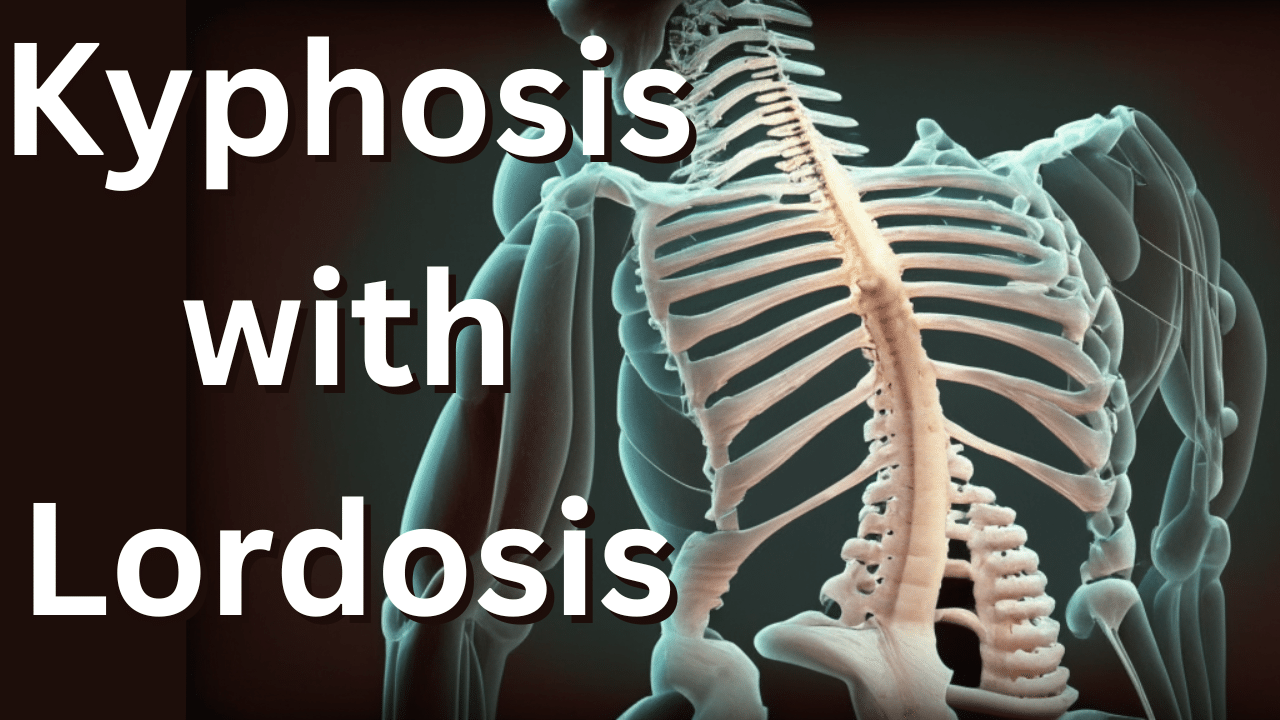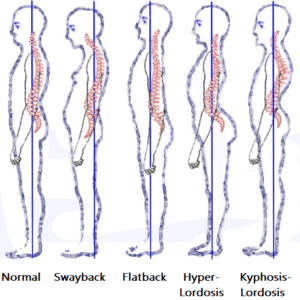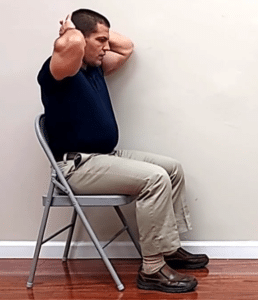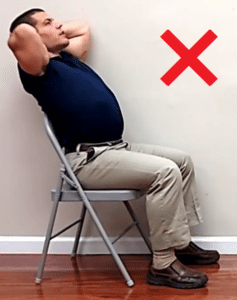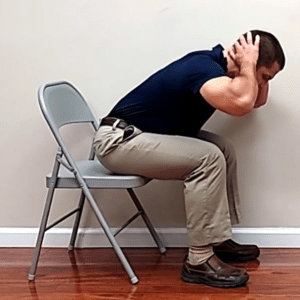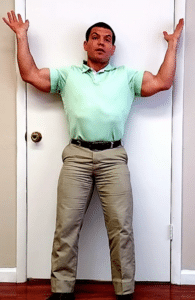Can You Have Both Kyphosis With Lordosis?
You CAN have both kyphosis with lordosis. In fact, you almost certainly DO have both kyphosis and lordosis.
In this video, you'll learn the difference between kyphosis vs lordosis curves in the spine, and how serious of a problem they are. Furthermore, you'll learn about the possibility of reversing kyphosis, and exercises to help you do so.
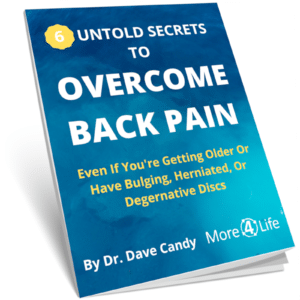
What's The Difference Between Kyphosis vs Lordosis?
Kyphosis and lordosis are both natural curves present in the spine.
A kyphosis curve is where the convex side of the spinal curve faces backward, such as in the thoracic spine, sacrum, and coccyx.
A lordosis curve is where the convex side of the curve is faces forward, such as in the cervical and lumbar spine.
The spine alternates kyphosis with lordosis curves to give the spine an S-shape. This shape helps humans to balance upright on two feet while providing both flexibility and shock absorption.
Causes of Kyphosis with Lordosis
Kyphosis and lordosis are normal features of the human spine.
Primary Curves (Kyphosis) vs. Secondary Curves (Lordosis)
- Primary Curves: Primary curves are the spinal curves that are present at birth. They develop during fetal development and are essential for the proper growth and development of the spine. The thoracic and sacral curves are considered primary curves.
- Secondary Curves: Secondary curves develop as a child grows and begins to sit, crawl, and walk. They gradually develop to allow the child to walk sit or stand upright. The cervical and lumbar spine are secondary curves.
If we only had primary (kyphosis) curves, we wouldn't be able to stand upright, so both kyphosis AND lordosis curves are normal and necessary to function as humans.
However, EXCESSIVE kyphosis and lordosis are NOT normal
Excessive kyphosis in the upper back can cause you to stand and walk hunched over, which most commonly occurs in older adults.
Excessive lordosis in the lower back, or hyper-lordosis can also cause problems such as:
When kyphosis and lordosis occur together, this posture is referred to as kyphosis-lordosis posture.
Causes of Excessive Kyphosis with Lordosis
Kyphosis and lordosis often occur together because when one curve gets exaggerated in one direction, the other curve compensates by becoming exaggerated in the other direction.
Several factors contribute to the development of kyphosis with lordosis, including:
- Poor Posture: Prolonged periods of slouching, sitting, or standing with a rounded upper back can gradually lead to an exaggerated kyphotic curve.
- Age-related Changes: As we age, the spinal discs lose hydration and height, contributing to the development of kyphosis. Additionally, degenerative conditions such as osteoporosis and arthritis can weaken the spine and contribute to abnormal curvature.
- Congenital Conditions: Some individuals may be born with structural abnormalities in their spine that predispose them to kyphosis with lordosis. One example of this is Scheuermann's disease
- Neuromuscular Disorders: Conditions like muscular dystrophy, cerebral palsy, and spinal muscular atrophy can weaken the muscles supporting the spine, leading to abnormal curvature.
Kyphosis in Neck (Cervical Kyphosis)
The cervical spine, or neck, can also develop kyphosis, particularly in the lower neck.
As the upper back becomes more rounded, it causes the head to move forward, resulting in a forward head posture. This misalignment can lead to neck pain, stiffness, reduced range of motion, headaches, and even neurological symptoms such as tingling and numbness in the arms and hands.
Mid-cervical kyphosis
Kyphosis in the middle cervical spine is relatively more rare, but it does happen.
A loss of curve in the neck or is referred to as flat neck syndrome or military neck. In severe cases, the curve of the neck may even reverse from a lordosis to cervical kyphosis.
Reversing Kyphosis: Is It Possible?
The possibility of reversing kyphosis depends on various factors, including the underlying cause and the severity of the condition.
If caught early before the kyphosis becomes structural or fixed, it is possible to reverse kyphosis. By reverse, I don't mean turn kyphosis into lordosis, but rather to reverse excessive kyphosis to a normal amount of kyphosis.
In other cases such as osteoporosis, arthritis, or Scheuermann's disease, complete reversal of kyphosis may not be possible. However, by addressing the problem quickly, you can at least prevent it's progression.
Treatment Kyphosis with Lordosis
The treatment for thoracic kyphosis depends on the cause. If you have osteoporosis, you want to have your bone density treated medically through diet, supplementation, and medication.
However, for all kinds of thoracic kyphosis, exercises can help improve your posture and prevent the progression of thoracic kyphosis.
Kyphosis with lordosis usually starts with thoracic kyphosis (with lordosis being compensatory).
Therefore exercises for kyphosis with lordosis should first focus on treating the thoracic curve.
Exercises For Thoracic Kyphosis
Watch the video above to learn 5 exercises for thoracic kyphosis including:
Seated thoracic extension over chair
Start by sitting all the way back against the chair. Then, perform a back arch over the chair.
This should NOT be an excessive arch from the lower back.
Instead, focus on lifting your chest and rib cage. It is a small movement, especially if you already have excessive kyphosis.
Seated thoracic extension with lumbar flexion
To prevent movement from the lower back, you can lean forward slightly and go into deflection in your lower back. Lift up a tiny bit from your chest.
This exercise becomes slightly harder than the previous ones because gravity is pushing down on you.
The advantage is though, this exercise strengthens your back extensor muscles, which help prevent excessive kyphosis throughout the day.
Standing thoracic extension with pelvic tilt
When standing, you can perform exercises to reduce kyphosis. One way to do this is by focusing on lifting through your chest and shoulders.
While standing, think about a small lift. Rolling your pelvis under can help lock your lower back and make it easier to lift from your upper back.
Standing back to wall thoracic extension
Another exercise is to stand against a wall with your feet slightly in front of you, ensuring your lower back is flat against the wall. Your shoulders may not touch the wall, especially if you already have kyphosis in your upper back. From this position, straighten up into the wall, performing a back extension.
Standing back to wall chest stretch
You can also try putting your arms up like a goal post which stretches your chest muscles.
Tight chest muscles can contribute to rounded shoulders and increased kyphosis, particularly if you spend a lot of time sitting at a desk or computer.
Therefore, stretching your chest muscles while extending your spine is an effective way to reduce kyphosis.
Conclusion
Kyphosis with lordosis is a spinal condition characterized by excessive forward curvature of the upper back combined with inward curvature of the lower back.
Excessive thoracic kyphosis can lead to neck or back pain.
While complete reversal of kyphosis may be challenging, the earlier you seek treatment for it, the better your chances are at reversing it, or at least keeping it from progressing.
If you need help for kyphosis or kyphosis with lordosis, our specialists at More 4 Life would be happy to help you. Just tap the button below to request an appointment.
Like this post? Check out some of our other post about exercises for lower back pain
Lean Forward When Walking? 3 Exercises to Stop Walking Hunched Over
8 Stretches For Lower Back Pain and Hip Mobility
7 Exercises For Arthritis In Lower Back
The 7 Best Core Strengthening Exercises For Lower Back Pain
Yoga Poses For Lower And Upper Back Pain
Chair Yoga Seniors Can Do For Neck Pain & Back Pain In 7 Easy Poses

